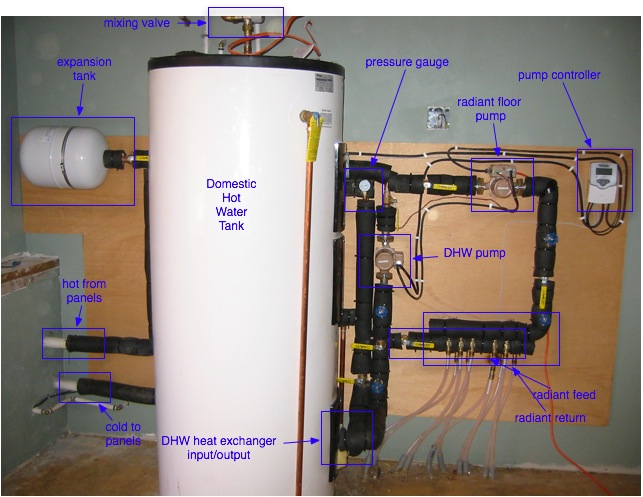Toby has done an awesome write up on our new solar hot water system. Click “more” to read it.

(Click here to open a slightly larger version of the picture in a new window)
Here is how the solar hot water system works:
We have two 4’x10′ collector panels behind the house, facing solar south. The panels contain a water/antifreeze mixture, which also fills the pipes running to/from the house, the pex tubing in the slab, and the heat exchanger in the hot water tank. This system is a little different than typical solar radiant floor systems, in that the fluid that runs through the panels goes directly through the floor. A typical system will have a secondary heat storage tank for the floor, and a boiler to provide additional heat for the floor. We opted not to build our system that way, for several reasons:
- our slab is smaller than the typical radiant system, and does not require as much energy
- a boiler would burn propane – something we are trying to avoid
- cost! boilers are expensive
Here are the components of the system, and a bit about how they work together (refer to the picture above):
- hot/cold from/to panels – this is where the fluid from/to the panels passes through the wall. Outside, these tubes are encased in insulation and buried in the ground (or will be, once we fill in the trench).
- expansion tank – allows the fluid to expand a bit with temperature changes
- pressure gauge – Displays the pressure of the fluid. Its normal operating pressure is 15 to 20 psi. If the pressure gets to 75 psi, there is a pressure release below the gauge (not labeled in the picture) that will dump the fluid until pressure has dropped. If this were to happen, the system would have to be re-pressurized. In theory this should only happen during a power failure in the summer on a sunny day, when the panels are very hot and the pumps are not able to run.
- pump controller – the brains of the operation. It has connected to it three temperature sensors: one at the collectors, one inside the domestic hot water heater, and one on the radiant floor return. Based on differences between these sensors, the controller will turn on/off the pumps.
- radiant floor pump – circulates the fluid through the slab to heat it. This pump will be turned on by the pump controller when the following conditions are true:
* the temperature at the sensor at the collectors is 15 (or more) degrees F greater than the temperature at the sensor on the radiant return
* the house thermostat wants the heat to be on
This pump will run until:
* the temperature at the sensor at the collectors is 2.5 (or less) degrees F greater than the temperature at the sensor on the radiant return
* the house thermostat wants the heat to be off - domestic hot water tank – a 120 gallon tank for our hot water. It has a 20 square foot heat exchanger in the bottom, and an electric heating element in the side for backup.
- DHW pump – circulates fluid through the domestic hot water (DHW) tank to heat it. This pump will be turned on by the pump controller when the following conditions are true:
* the temperature at the sensor at the collectors is 15 (or more) degrees F greater than the temperature at the sensor in the tank
* the temperature sensor in the tank reports that the temperature is less than 175 degrees F
This pump will run until:
* the temperature at the sensor at the collectors is 5 (or less) degrees F greater than the temperature at the sensor in the tank
* the temperature sensor in the tank reports that the temperature is greater than or equal to 175 degrees F - mixing valve – this is a temperature sensitive mixing valve that will mix cold water with the hot coming out of the tank to temper it to a more comfortable temperature, and to keep more of the heat energy in the tank.
If conditions are right, it is possible and likely for both pumps to be operating at the same time, and sharing the heat between the floor and the DHW tank.
The pump controller has a feature where it will override some of the above pump control rules to try to shed excess heat to prevent the fluid pressure from getting to high.
Oh, I thought this was going to be about a trip to Jupiter!
Seriously, that’s a great exposition on your heating system. Is it running now?
Yep, up and running. though it will take a long while to heat up the slab for the first time.